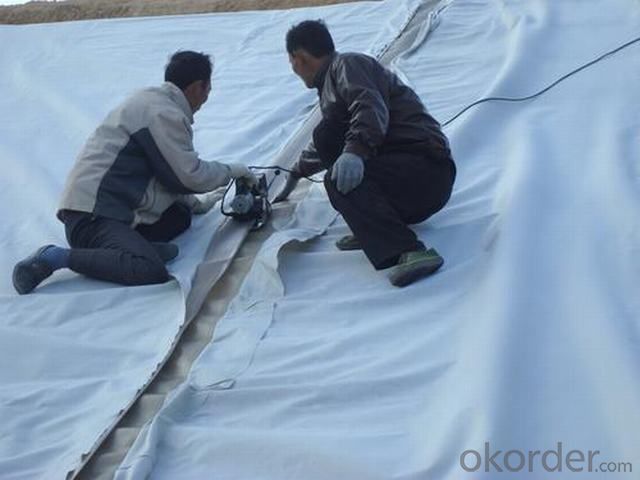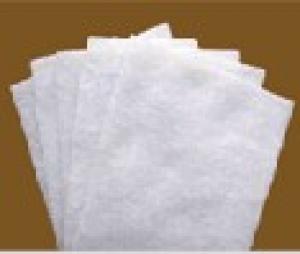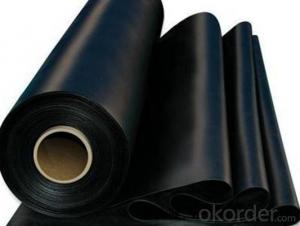Manas Geotextile for Reinforced Filtration Road
- Loading Port:
- Qingdao
- Payment Terms:
- TT OR LC
- Min Order Qty:
- 20000 m²
- Supply Capability:
- 1500000 m²/month
OKorder Service Pledge
OKorder Financial Service
You Might Also Like
Specifications of Geotextile for Reinforced Filtring Road:
-Reinforced filtering road geotextile
-quality:good quality
-strength:high strength
-tencity:well
-packagel:woven bags
TDS of Geotextile for Reinforced Filtring Road:
NO | Reinforced filtring road geotextile | |
1 | Materaial | Polyester (PET) and polypropylyne(PP) |
2 | Delievery | 7 days after payment |
3 | Package | Woven bags usually, as your requirement |
4 | Color | White,black,gray |
5 | Install | Convinient and safely |
6 | Sale Status | Popular and well selling |
7 | Payment | TT/LC/Western Union,Paypal |
8 | Price | 01-4.0 USD |
9 | After sale service | Professional suggestions and send sample if you want |
- Q: Can geotextiles be used in green roof applications?
- Yes, geotextiles can be used in green roof applications. Geotextiles are often used as a protective barrier or filter layer in green roofs to prevent soil erosion and aid in drainage. They can help retain moisture and provide stability to the growing medium, promoting healthy plant growth on green roofs.
- Q: How do geotextiles help with slope stabilization?
- Geotextiles help with slope stabilization by providing reinforcement and retaining soil on slopes. They act as a barrier, preventing erosion and the movement of soil particles, while still allowing water to pass through. This helps to maintain the stability of slopes and prevents landslides or slope failures.
- Q: How much is the geotextile machine?
- Geotextile is very cheap a few hundred dollars, geomembrane is more expensive, 4000-8000 yuan, I specializing in the production of geomembrane geotextile
- Q: What are the specifications for geotextiles in green roof applications?
- Geotextiles used in green roof applications typically have specific specifications such as high tensile strength to withstand the weight of the vegetation and soil, excellent water permeability to allow efficient drainage, UV resistance to withstand prolonged exposure to sunlight, and appropriate thickness to provide adequate protection for the underlying layers of the green roof system.
- Q: What are the different geotextile permeability testing methods?
- There are several different geotextile permeability testing methods, including the constant head method, falling head method, and gradient ratio method.
- Q: Can geotextiles be used in wastewater treatment systems?
- Yes, geotextiles can be used in wastewater treatment systems. They are commonly used in various stages of the treatment process, such as filtration, separation, and dewatering. Geotextiles can help in removing solid particles, preventing clogging, enhancing filtration efficiency, and providing structural support to the system.
- Q: Geomembrane upstream protective layer with what material? The Why can not you use clay?
- With geotextile to do protective layer, because the geotextile and geomembrane as with acid and alkali, is the characteristics of corrosion, the useful life of more than 50 years can better protect the geomembrane. Clay and its performance is far from the comparison, so the use of geotextile hides to avoid waste Zhuan belly over the sand to make the upper reaches of the protective layer. Inquire about Yinjing Li
- Q: What are the installation techniques for geotextiles?
- There are several installation techniques for geotextiles, depending on the specific application and site conditions. Some common techniques include anchoring the geotextile with stakes or pins, securing it with sandbags or gravel, or using mechanical devices such as anchors or screws. The geotextile may also be overlapped and sewn together, or heat-welded to create a continuous barrier. It is important to follow the manufacturer's guidelines and industry standards when installing geotextiles to ensure proper functionality and longevity.
- Q: Are geotextiles resistant to fire?
- Yes, geotextiles can be made resistant to fire through the use of specific materials and treatments.
- Q: Are geotextiles suitable for use in dam construction?
- Yes, geotextiles are suitable for use in dam construction. They can act as filters, separators, and reinforcements, providing erosion control, soil stabilization, and increased strength to the dam structure. Geotextiles can help prevent seepage, improve drainage, and enhance the overall performance and longevity of the dam.
Send your message to us
Manas Geotextile for Reinforced Filtration Road
- Loading Port:
- Qingdao
- Payment Terms:
- TT OR LC
- Min Order Qty:
- 20000 m²
- Supply Capability:
- 1500000 m²/month
OKorder Service Pledge
OKorder Financial Service
Similar products
Hot products
Hot Searches
Related keywords






























